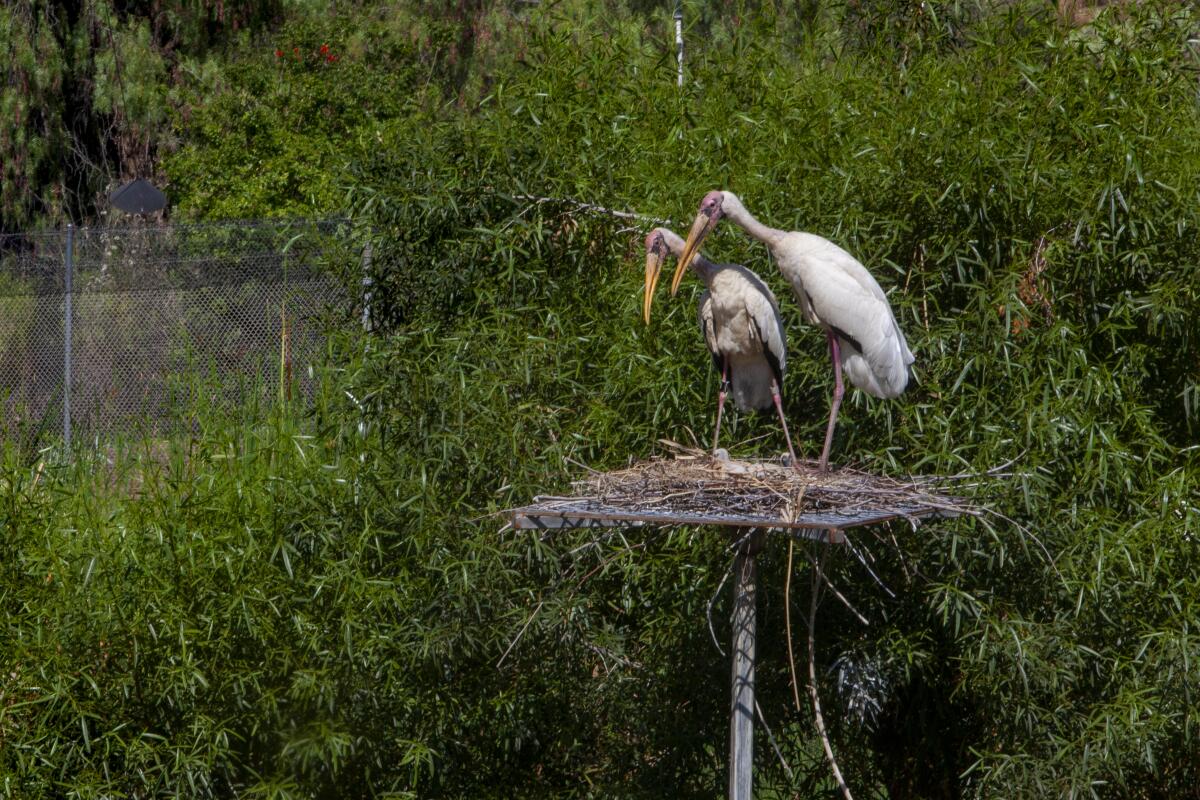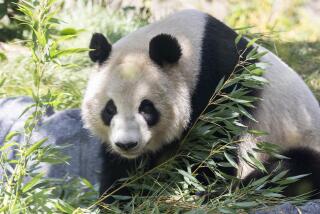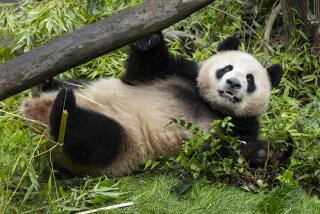Only 24 of these storks are in North America. The San Diego Zoo and Safari Park have them

- Share via
SAN DIEGO — Three recently hatched milky storks at the San Diego Zoo Safari Park have raised hopes that a species fast disappearing from its natural habitat could one day mount a comeback.
The 1-week-old hatchlings are among the only 24 members of their kind found in North America’s zoos. All these birds now live under the care of the San Diego Zoo and San Diego Zoo Safari Park, where staff are racing against time to establish a successful captive breeding program.
There’s clear need for such an effort, says Jenny Tibbott, the Safari Park’s senior bird keeper. These endangered birds are struggling to survive in the mangroves of Southeast Asia, where there are only 2,200 milky storks left. That number is likely to dip further as people continue to turn their habitats into commercial fish farms.
“I see a real sad common thing happening with many species,” she said. “I see this species extremely declining in the wild, nothing getting better, and then we’re at a point where we look around and they only exist in zoos. Talk about pressure.”
Reintroducing storks born in captivity into the wild could one day be the species’ best bet for survival, similar to the zoo’s famed condor breeding program. But that effort won’t succeed without two things, Tibbott says: policies that protect these birds and a healthy, genetically diverse population.
The Safari Park’s breeding program is focused on the latter. In March, the park received the last milky storks in North America not already under the care of San Diego Zoo Wildlife Alliance — eight birds from the Audubon Zoo of New Orleans.
Those new arrivals joined six storks at the Safari Park in a large enclosure meant to mimic their native mangroves, lush with trees and long grass and ponds packed with papyrus and cattails. The ponds are stocked with live fish for the storks to hunt. Wild frogs and snakes have snuck in, but that’s just fine, Tibbott, says, as the storks enjoy snapping them up, too.
It didn’t take long for the birds to start pairing up, with males and females preening one another and clicking their bills at each other — a stork’s way of greeting and courting a potential mate.
Around late May, one female stork began laying eggs, all three of which hatched between June 21 and 23. For now, each chick is essentially a cloud of white feathers with a black bill and an insatiable appetite for regurgitated food from its parents.
In about a month, they’ll make their first forays outside their nest. It’ll take them longer to learn how to fly and to acquire their characteristic yellow bill and red head. An adult milky stork stands about 3 feet tall and can live up to 30 years or more in captivity.
There are seven other milky storks at the zoo, including a chick that hatched earlier this year. All of them will likely join the Safari Park group later this summer. The birds will be in a part of the park guests generally don’t have access to, where keepers care for a number of endangered bird species. And while that means you probably won’t see these storks any time soon, Tibbott says, the work of preserving this embattled species will quietly continue.
“This is, I think, what we should be all about. And this is the heart of why a place like this exists,” she said. “If we’re not doing this, then we shouldn’t exist.”
More to Read
Sign up for Essential California
The most important California stories and recommendations in your inbox every morning.
You may occasionally receive promotional content from the Los Angeles Times.











